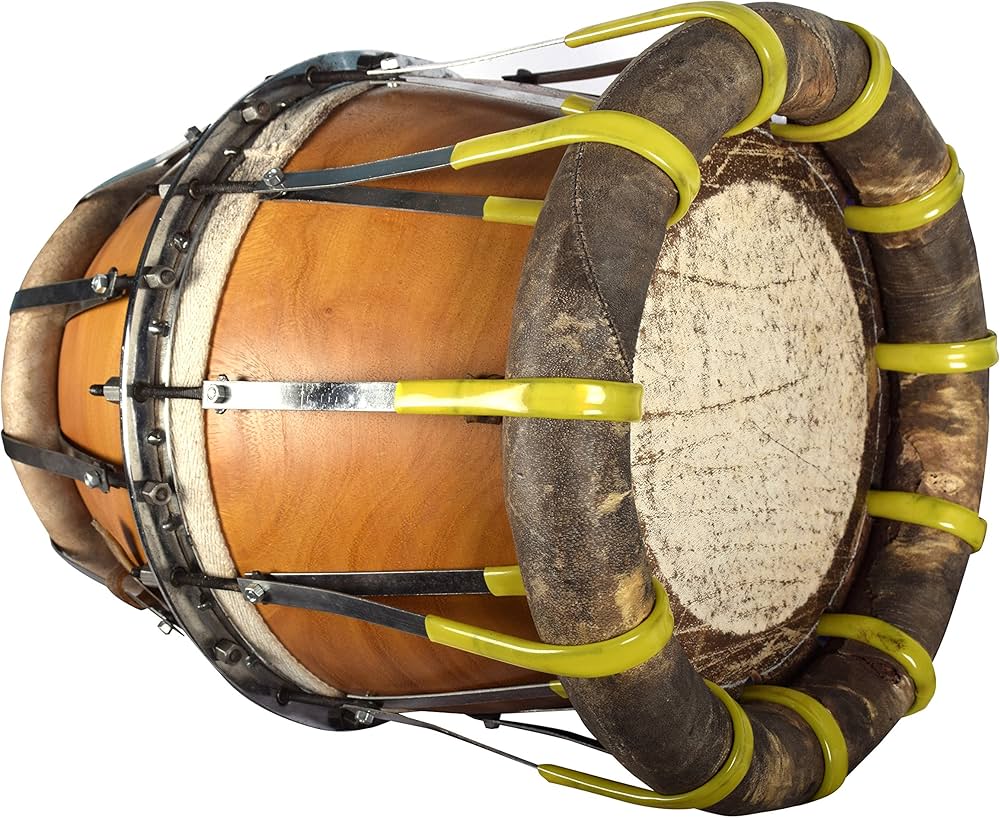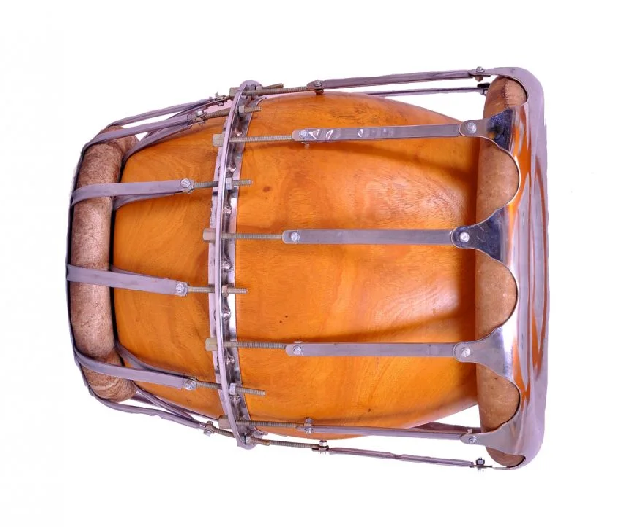Thavil
Percussions
Asia
Between 1001 and 1900 AD
Video
The thavil is a traditional barrel-shaped percussion instrument originating from South India, particularly associated with the Tamil Nadu region. It is characterized by its robust construction and dynamic sound, making it an essential component in various musical traditions, especially in Carnatic music.
It is traditionally played alongside the nadaswaram, a prominent wind instrument, during religious ceremonies, festivals, and cultural events. Its unique sound and rhythmic capabilities contribute significantly to the overall musical experience in these settings. It produces sound through the vibration of its drumheads when struck. It falls under the Hornbostel-Sachs classification 211.212.1, which categorizes it as a directly struck membranophone with two usable membranes. The thavil is notable for its ability to produce a wide range of pitches and dynamics, making it versatile for various musical contexts.
History
The thavil has a rich history that dates back several centuries, primarily in South India. Its origins can be traced to Tamil Nadu, where it has been an integral part of the region’s musical heritage since at least the 16th century. The instrument has evolved, influenced by cultural exchanges and regional musical practices. Historically, the thavil was often associated with temple music and folk traditions, serving as a rhythmic foundation for various performances. During the 19th century, the thavil gained prominence in classical music ensembles, particularly in conjunction with the nadaswaram. This period saw the formalization of performance practices and the establishment of thavil as a staple instrument in Carnatic music concerts. Today, it continues to be a vital part of South Indian cultural celebrations and rituals.
Construction
The Thavil is crafted primarily from a solid block of jackfruit wood, which is hollowed out to create a cylindrical shell. The dimensions of the Thavil typically measure about 16 inches in length with a diameter of approximately 13.5 inches at its widest point. The drumhead consists of animal skins—commonly water buffalo skin on the right side and goat skin on the left—stretched tightly across the shell using hemp hoops and leather straps. The right face of the Thavil is larger and more tightly stretched than the left, which allows for pitch bending; this design contributes to the distinct tonal qualities of the instrument. Modern Thavils may also feature synthetic materials for durability, particularly in regions with extreme weather conditions. The skins are held in place by a series of bamboo hoops that are bundled and tied together with hemp, while additional leather braces encircle the middle section to facilitate tuning adjustments. This meticulous construction ensures that both drumheads can be individually tuned, allowing players to achieve a wide range of pitches and dynamic sounds.
Types
While there are no formal classifications of Thavil types, variations exist based on regional styles and playing contexts. For instance, the Thanjavur Thavil is renowned for its craftsmanship and sound quality, often associated with performances in the Thanjavur region. Additionally, players may adapt their instruments slightly depending on whether they are performing in folk settings or classical concerts.
Features
The Thavil’s design includes several notable features that enhance its playability and sound production:
Barrel Shape: This shape not only contributes to its aesthetic appeal but also affects the resonance and projection of sound.
Dual Drumheads: The differing tensions between the right and left drumheads allow for a rich variety of tones.
Playing Position: The Thavil can be played while seated or hung from a strap around the player’s neck, providing flexibility during performances.
Thumb Caps: Players often wear thumb caps made from hardened glue or flour on their right-hand fingers to enhance grip and protect their hands while playing.
Sound Production
Sound production in the Thavil is achieved through striking its two drumheads with different techniques. The right head is played using the fingers and palm of the right hand, which allows for intricate rhythms and dynamic expressions. The player typically uses thumb caps to facilitate faster playing while protecting their fingers from impact. The left head is struck with a thick stick made from the wood of the portia tree; this stick produces a contrasting sound that complements the tones generated by the right head.The combination of these two playing techniques enables musicians to create complex rhythmic patterns that are essential to both folk and classical music performances. The Thavil’s ability to produce deep bass sounds as well as sharp, high-pitched tones makes it an incredibly versatile instrument within ensembles.
Roles in Music
The Thavil occupies a central role in various musical contexts throughout South India:
Carnatic Music: In classical Carnatic music performances, the Thavil serves as an essential accompaniment to Nadaswaram concerts. Its powerful sound complements the melodic lines produced by wind instruments, creating a vibrant auditory experience that enhances both solo performances and ensemble works.
Folk Music: The Thavil is integral to folk traditions across Tamil Nadu and surrounding regions. It is commonly played during festivals, weddings, and community celebrations where its lively rhythms encourage participation and dancing among audiences.
Ceremonial Use: In religious contexts, particularly during temple festivals and processions, the Thavil plays a vital role in creating an atmosphere of reverence and celebration. Its commanding sound helps signal important moments during rituals and ceremonies.
Cultural Symbolism: Beyond its musical functions, the Thavil symbolizes cultural identity among Tamil communities. It represents continuity in tradition and serves as a means of cultural expression that connects generations through music.
Educational Contexts: In addition to performance settings, the Thavil is also taught in music schools where students learn traditional rhythms and techniques essential for mastering this instrument. This educational aspect ensures that knowledge about playing methods and cultural significance continues to be passed down through generations.
The Thavil is much more than just a musical instrument; it embodies rich cultural traditions and serves diverse roles within South Indian music. Its unique construction allows for dynamic sound production while its playing methods highlight intricate techniques essential for performance. Whether accompanying classical compositions or driving folk dances at community festivals, the Thavil remains an indispensable element of South India’s vibrant musical landscape.
FAQ
What are the key features of the Thavil musical instrument?
The Thavil is a barrel-shaped percussion instrument made from a solid block of jackfruit wood. It has two drum heads, one tightly stretched for higher pitch and the other looser for pitch bending. Typically, it is played using fingers on the right side and a stick on the left, often while seated or hung from the shoulder.
What type of music is the Thavil primarily associated with?
The Thavil is predominantly used in Carnatic music and accompanies the Nadaswaram, a traditional wind instrument. It plays a crucial role in temple music, folk performances, and various cultural ceremonies across South India.
Who are some famous players of the Thavil?
Notable Thavil players include Amaan Ali Khan and other renowned musicians from Tamil Nadu. They are celebrated for their skill in performing traditional Carnatic music and contributing to its rich cultural heritage.
 Links
Links
References
Other Instrument
Categories



















